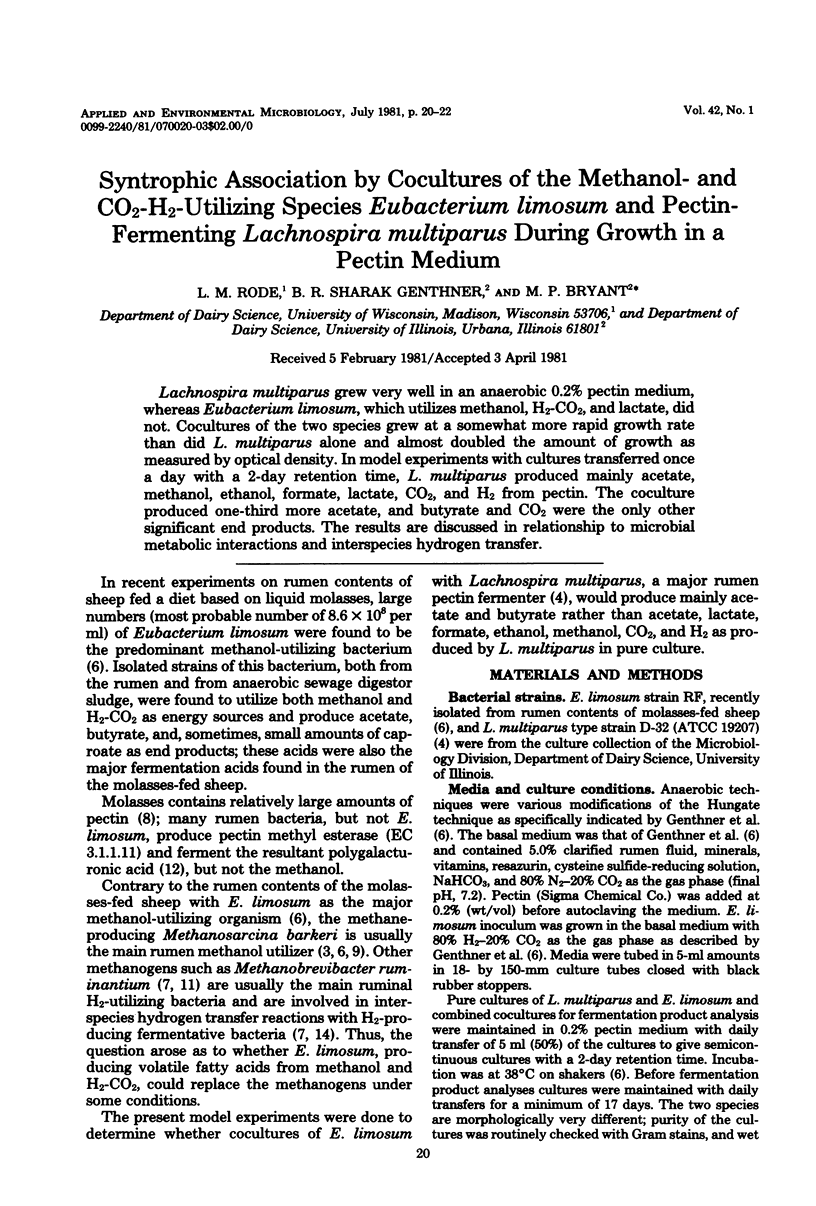Abstract
Lachnospira multiparus grew very well in an anaerobic 0.2% pectin medium, whereas Eubacterium limosum, which utilizes methanol, H2-CO2, and lactate, did not. Cocultures of the two species grew at a somewhat more rapid growth rate than did L. multiparus alone and almost doubled the amount of growth as measured by optical density. In model experiments with cultures transferred once a day with a 2-day retention time, L. multiparus produced mainly acetate, methanol, ethanol, formate, lactate, CO2, and H2 from pectin. The coculture produced one-third more acetate, and butyrate and CO2 were the only other significant end products. The results are discussed in relationship to microbial metabolic interactions and interspecies hydrogen transfer.
Full text
PDF


Selected References
These references are in PubMed. This may not be the complete list of references from this article.
- BEIJER W. H. Methane fermentation in the rumen of cattle. Nature. 1952 Oct 4;170(4327):576–577. doi: 10.1038/170576a0. [DOI] [PubMed] [Google Scholar]
- BRYANT M. P., SMALL N. Characteristics of two new genera of anaerobic curved rods isolated from the rumen of cattle. J Bacteriol. 1956 Jul;72(1):22–26. doi: 10.1128/jb.72.1.22-26.1956. [DOI] [PMC free article] [PubMed] [Google Scholar]
- BRYANT M. P., SMALL N. The anaerobic monotrichous butyric acid-producing curved rod-shaped bacteria of the rumen. J Bacteriol. 1956 Jul;72(1):16–21. doi: 10.1128/jb.72.1.16-21.1956. [DOI] [PMC free article] [PubMed] [Google Scholar]
- Genthner B. R., Davis C. L., Bryant M. P. Features of rumen and sewage sludge strains of Eubacterium limosum, a methanol- and H2-CO2-utilizing species. Appl Environ Microbiol. 1981 Jul;42(1):12–19. doi: 10.1128/aem.42.1.12-19.1981. [DOI] [PMC free article] [PubMed] [Google Scholar]
- RABINOWITZ J. C., PRICER W. E., Jr An enzymatic method for the determination of formic acid. J Biol Chem. 1957 Nov;229(1):321–328. [PubMed] [Google Scholar]
- SMITH P. H., HUNGATE R. E. Isolation and characterization of Methanobacterium ruminantium n. sp. J Bacteriol. 1958 Jun;75(6):713–718. doi: 10.1128/jb.75.6.713-718.1958. [DOI] [PMC free article] [PubMed] [Google Scholar]
- Wolin E. A., Wolfe R. S., Wolin M. J. Viologen dye inhibition of methane formation by Methanobacillus omelianskii. J Bacteriol. 1964 May;87(5):993–998. doi: 10.1128/jb.87.5.993-998.1964. [DOI] [PMC free article] [PubMed] [Google Scholar]
- Wolin M. J. Metabolic interactions among intestinal microorganisms. Am J Clin Nutr. 1974 Nov;27(11):1320–1328. doi: 10.1093/ajcn/27.11.1320. [DOI] [PubMed] [Google Scholar]


